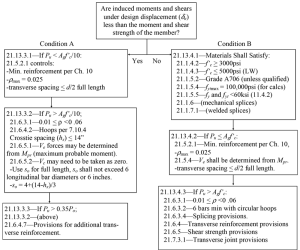Do ACI Seismic Provisions Apply?
The title of this article may seem like a trivial question, but it deals with an issue that in large measure might be overlooked. At first glance, one might think, “Of course not; gravity columns are designed for gravity, so why would I need to address the seismic provisions in Chapter 21 of ACI 318-11?” The answer is a simple matter of deformation compatibility, which ASCE 7-10 addresses for Seismic Design Categories (SDC) D through F in Section 12.12.5. It clearly lists reinforced concrete frame members not part of the lateral-force-resisting system as an exception, with a deferral to ACI 318-11 Section 21.11 – ASCE 7-10 Errata No. 2 corrects this reference to ACI 318-11 Section 21.13 – which is titled, “Members not designated as part of the seismic-force-resisting system”.
We can appreciate that gravity-load-carrying members are inextricably linked to the lateral-force-resisting system. Though not specifically designed to provide lateral stiffness, the performance and behavior of such elements can be significantly altered in a seismic event. Hence, we must deal with deformation compatibility issues and ductility requirements for reinforced concrete gravity columns during a seismic event, in accordance with ACI 318-11 Section 21.13.
How do we know when it is required to incorporate the ACI seismic provisions for gravity members? In general terms that match the ACI code language, gravity members are those “not designated as part of the seismic-force-resisting system in structures assigned to SDC D, E, and F” mentioned in section 21.13.1 of ACI 318. The same section of ACI indicates that members not explicitly checked may just be designed using the ACI 21.13.4 provisions, which may be onerous. It is interesting to note that earlier versions of ACI 318 Chapter 21 qualified members requiring such attention in “regions of high seismic risk,” which led to some ambiguity and confusion, especially for structures seemingly on that threshold. Currently, ACI uses the more direct Seismic Design Category language.
ACI 318-11 Section 21.13.3 addresses induced moments and shears under design displacements (δu), which are taken as the magnified displacements using the appropriate Cd factor multiplied by the elastic displacements using pseudo-static elastic analysis methods. ACI 318-11 Chapter 21 identifies two conditions for seismic detailing of gravity members, which are distinguished by the strength trigger and, for convenience, are hereafter referenced as Conditions A and B.
Condition A pertains when induced moments and shears due to displacements, δu, combined with the effects of gravity moments and shears, do not surpass the strength of the column. In such cases, the provisions of Sections 21.13.3.1 through 21.13.3.3 must be satisfied, and the more critical load combination of (1.2D+1.0L+0.2S) or 0.9D must be used. The factor for live load (L) may be reduced to 0.5 in accordance with standard provisions of the Strength Design Load Combinations. For Condition B, induced moments and shears surpass member strengths and greater ductility detailing is in order, since the analysis predicts that the member will yield. Section 21.13.4 thus controls.
The Figure provides a flow chart indicating the ACI 318-11 Chapter 21 provisions that may be applicable. It contains the referenced code provisions and very brief descriptions thereof – an abbreviated summary due to limitations of space and the complexity of the code, but it does provide the appropriate direction. Essentially, these provisions provide triggers based on the levels of axial, bending and shear load that increase the need for seismic detailing – in many cases the same detailing as that required for members of the lateral-force-resisting system.
The ACI seismic provisions that are applicable to members not proportioned to resist lateral forces – i.e., gravity members – are complex and can significantly alter the minimum requirements. Among the triggered detailing requirements are increased longitudinal reinforcement, volumetric determination of ties and stirrups, ties and stirrups along the entire member lengths, cross tie requirements, and a generalized decrease in tie/stirrup spacing. A simple example of this is column ties. The ACI 318-11 Chapter 7 provisions for tie spacing are quite simple: 16 vertical bar diameters, 48 tie diameters, or the least column dimension. However, the Chapter 21 provisions are far more complex and may require a much tighter tie spacing, typically not more than 6 inches.
Why such onerous provisions? Reconnaissance efforts and other learning experiences from recent earthquakes have shown time and time again that reinforced concrete can demonstrate excellent ductility when it is appropriately reinforced. The ACI 318-11 Chapter 21 provisions provide a logical and rational approach for determining whether gravity members are at risk, and to what extent their reinforcements should approach the ductile detailing provisions normally applied to members that are part of the lateral-force-resisting system. It really should not be surprising to find that the transverse reinforcement of a gravity column might not be too different from that of a moment frame column.
Another worthy note is that these provisions are driven by drift of the structure, which only makes sense. Following this, we should expect that more flexible lateral systems, such as concrete moment frames, will likely have greater densities of transverse reinforcement in gravity members than their stiffer counterparts, such as shear walls – a fact often overlooked when considering the pros and cons of different lateral systems.▪
A similar article was published in the Structural Engineers Association-Utah (SEAU) Monthly Newsletter (February, 2006). Content is reprinted with permission.

